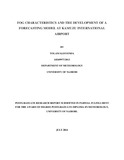| dc.description.abstract | The prediction of fog occurrence, extent, duration and intensity remains elusive despite improvements in numerical guidance and modeling of the fog phenomenon. This is because of the dependency of fog on microphysical and meso-scale processes that act within the boundary layer and that, in turn, are forced by the prevailing synoptic regime. With the availability of new technologies and techniques to the operational forecaster already in use, fog prediction may be greatly improved by the development and application of a statistical model. A preliminary attempt at such a model is presented for the Kamuzu International Airport, Lilongwe, Malawi. This requires knowledge of winds, temperatures and moisture availability among others.
The data used is from 2009 to 2014 obtained from the Department of Climate Change and Meteorological Services (DCCMS) headquarters in Blantyre and consists of synoptic observations for Kamuzu International Airport. The data includes dry bulb (screen) temperature, dew point temperature, wind speed and direction.
Results indicate that most fog events at KIA were recorded under calm winds, wind speeds less than or equal to 2 m/s and South Easterly winds. Fog occurrence per month is highest in May, June and July which coincide with the winter season. Minimum temperatures and low dew point depression are favorable for fog formation, which are mainly observed around 0300UTC. The mean critical fog formation temperature is 10.94 degree Celsius.
The temperatures at fog onset have shown a significant correlation with both the corresponding dew point and screen temperatures at 2300 UTC. A multiple regression model that uses the screen temperatures at 2300 UTC ( ) and dew point depressions at 2300 UTC ( ) for the prediction of the critical temperature of fog onset is then developed. The model is validated using the F-test (F calculated (147) greater than F critical, (3.09)). The Hit Rate of the model is 83.33%. | en_US |

